During the visit
The learning story board – stages on the LEOTC learning pathway
Planning – how did we start?In the classroom | The learning experience – handling informationAt the museum |
Exploring broad understandings | Collecting information |
|---|---|
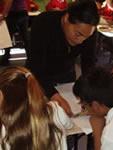 |
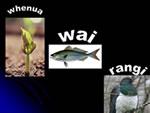 |
| Teachers brainstormed pre-visit activity to assess the students' knowledge of Matariki. They were at the beginning of the unit and the visit was to serve as an inspiration and launching pad for this year's focus. | The museum visit began with a formal welcome and an explanation of the activities. There was an interactive korero about Matariki, using a slide show to ascertain the students' prior knowledge. Students contributed ideas and shared their knowledge of the names of the stars in the constellation. The educator then linked the concepts of food, harvest, and preparation for spring planting and how they link to Matariki. The meaning of whakatauki (proverbs) was discussed and how they related to Matariki. The students were all involved in listening and sharing their ideas. |
Collecting and processing information | |
|---|---|
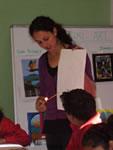 |
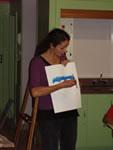 |
| The LEOTC educators used works by New Zealand artists that showed traditional foods and illustrated the skills of colour mixing and colour use. | A LEOTC educator demonstrated each stage of the creative process while students developed their own work. The method of colour blending was new to many of them and they worked hard to achieve the result that was being modelled. |
Processing information/developing skills | Collecting information |
 |
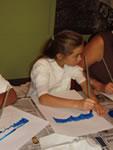 |
| The skills being taught were practised as students created their work. | The educator used te reo Māori to teach the techniques. |
Processing information/ developing skills | Collecting information/processing information | Collecting information |
|---|---|---|
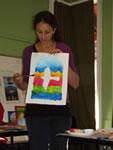 |
 |
 |
| Students improved their technique as examples of good practice were shown. They continually modified their work until they were satisfied with the result. | The educator discussed the location and arrangement of the Matariki constellation. Star stickers were chosen by the students and applied to their pictures. | The other educator took the class into the exhibition Te Huringa/Turning Points and led a discussion about how the exhibits related to their own works. The students were instructed in how to move around and how to respect the artworks on display. They explored the gallery in small groups and discussed aspects of the artworks with teachers and museum staff. |
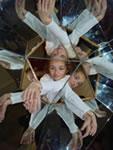 |
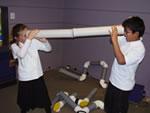 |
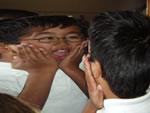 |
| There was also a travelling science-based exhibition on mirrors at the museum, which most students had not seen before. The LEOTC educator introduced the exhibition and then the students explored the interactive exhibits. Although this experience was not directly linked to their current unit of work, students moved around with enthusiasm and interest. They experimented with the equipment, discussed what was happening and referred to the explanatory booklets beside each display. This area provided a change of energy and the students enjoyed the physical activity of moving freely around the room. There was a buzz of excitement as students enjoyed seeing their bodies distorted in the mirrors, tried to pick up virtual images of jelly beans, and waved their arms like octopuses. Students were calling out to the teachers and educators, showing them what they had found out and wanting to share their excitement. | ||
| Processing information/ developing skills | ||
|---|---|---|
 |
 |
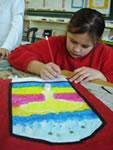 |
| The artwork was completed by painting a frame and gluing on a black border. | The class discussed the whakatauki (proverbs) that had been introduced at the museum. They completed the follow-up sheet which had been provided at the museum. | The proverbs were then related to the picture and an appropriate proverb was chosen to write beneath the image. |
Communicating findings | Reflecting and evaluating | Where could we go next? |
|---|---|---|
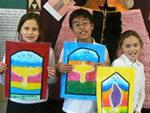 |
 |
 |
| The artworks went on display. Students then planned a concert celebration for Matariki and used their knowledge of proverbs and traditions to plan songs and plays to perform to the school community. | The students commented on their artworks, which incorporated much of the korero at the museum. They used the pictures to help with recall and to consider what they had learned. One student reflected on the learning that occurred at the museum and how she would like to return to find out more. | The class will be revisiting Matariki next year and continue to build on prior knowledge to develop an all-round understanding of those traditions. Many students expressed a desire to return to the museum to revisit the artworks and the mirror exhibition that they experienced. |
During the visit: Recording learning
Learning behaviours and conversations were recorded while the students were on their visit.
During the art session there was very little conversation as the students were engrossed in their painting. Details of discussions with the educator are recorded but the conversation was not captured as the researcher was not fluent in te reo Māori.
| KC - Managing Self | KC – Managing Self, Relating to Others, Thinking | |||
|---|---|---|---|---|
| Learning behaviour | Learning conversation | Learning behaviour | Learning conversation | |
| Student 1 | Following instructions when painting; asking questions about technique when unsure. | Listening intently to educator's introduction; painting with care and attention focused on the task. | ||
| Student 2 | Questioning LEOTC educator about painting technique when unsure about it. | Listening to the introduction and responding with answers to questions. | ||
| Student 3 | Moves freely about the Bedazzled exhibition trying to work out and explain how the exhibits work. Delights in the effects the mirrors have on his reflection. | Focused painting, following instructions and working quickly through the stages. | ||
| KC – Thinking | KC – Thinking | |||
| Learning behaviour | Learning conversation | Learning behaviour | Learning conversation | |
| Student 1 | Moving round the Bedazzled exhibition, exploring and testing out the interactive exhibits. | Examining exhibits in Bedazzled, referring to explanatory booklet and returns to exhibit to check understanding. | ||
| Student 2 | Spent some time with a shape exhibit that created 3D shapes. Referred to the booklet to see how it worked. | Carefully following instructions in the development of the artwork. | ||
| Student 3 | Enjoys manipulating the large mirror to change the reflection of himself and his friends. | Relating paintings in the gallery to the artworks students had created. | Look at the way the artist has painted this part. Cool, the colours are like the ones we did. | |
| KC – Relating to Others, Participating and Contributing | KC – Using Language, Symbols, and Texts | |||
| Learning behaviour | Learning conversation | Learning behaviour | Learning conversation | |
| Student 1 | Bringing LEOTC educator over to have a look at a display that interested her. Showing a friend how to work an exhibit, commenting on what was happening. | Look at this, you can see heaps of eyes; you have a go; have a look at me.
Teacher: How does it work? There are a million lights when you turn it. There's a mirror here and a mirror here. They're reflecting to each other. | Experiencing a PowerPoint presentation about Matariki then using the information on her picture back at school; participating in korero in Māori and English. | |
| Student 2 | Holding a conversation with her partner about the displays. | This is cool, move the mirror and see what happens (laughing) look at how long my legs are when you move it. Now move it the other way. | Reading and then following text instructions for Bedazzled exhibits; participating in korero in Māori and English. | |
| Student 3 | Keen to share his enjoyment in the Bedazzled exhibition with teachers and peers. | Using artworks from the past to discover what life might have been like in those times; participating in korero in Maori and English. | ||
| KC – Thinking | ||||
| Learning behaviour | Learning conversation | Learning behaviour | Learning conversation | |
| Student 1 | Calling people over to exhibits and sharing how they worked. Talking about artwork. | Observer: That's great; do you like it? Yes, I am really happy with what I have done. | ||
| Student 2 | Talking to the observer about artwork. | I really liked the painting but I would have liked to have used different colours rather than the ones they said. Observer: Are you interested in colours? Yes, art is my favourite subject. I would like to be an artist. | ||
| Student 3 | Working quickly and efficiently; the first to finish painting. Showing his work to LEOTC educator, and asking what to do next. | Discussing aspects of a picture with teacher and small group of friends. Differences of opinion emerge as to why the taiaha is upside down; the teacher refers to the interpretive panel and discusses possible reasons with the group. | Why has he got the taiaha upside down, that is tapu. Group member: He must be doing it for a reason. Teacher: The artist does that to show the people's connection to the land. Oh, is that why? Group member: It is still tapu. | |
| KC – Managing Self; Participating and Contributing; Relating to Others | KC – Thinking | |||
| Learning behaviour | Learning conversation | Learning behaviour | Learning conversation | |
| Student 1 | Moving respectfully around the artworks in the gallery without touching. | Examining the Bedazzled exhibits closely, trying to work out what was happening. | ||
| Student 2 | Listening to museum staff with respect; moving round quietly and sensibly. | |||
| Student 3 | Very interested in the artworks on display, moving slowly round observing each carefully but keeping appropriate distance. | Reflecting when looking at artworks; impressed by the very detailed images that were like photographs. Talking about how hard that would be to create. | ||
During the visit: Students' voice
As they were leaving the museum, the students were clear about what they had learned and enjoyed. They had all found out more about Matariki through the korero and art experience. They also had questions that they were keen to follow up on.
| Student 1 | Student 2 | Student 3 | |
|---|---|---|---|
| What do you think the main ideas were that you experienced today? | Matariki. I didn't know it had to do with gathering food from the land and sea as well as just the stars in the sky. | Matariki. What people were doing at that time; also the names of the stars. | Doing art and learning about the harvest. It was fun mixing two colours to make other colours to look like the paintings we saw. |
| Were there some things that you found particularly interesting that you might tell someone about? If so, what? | I really liked the mirrors; also learning to paint and mixing the colours. | How the stars are small and big. | Looking at the art exhibition – it was cool to look at it and see all the new and old paintings. |
| What would you like to follow up on, or learn more about? | I would like to ask more questions, like why did they name it Matariki? | Maybe more about the stars. | Heaps more about Matariki. How old is it? I am more interested in it now than before I came. |

